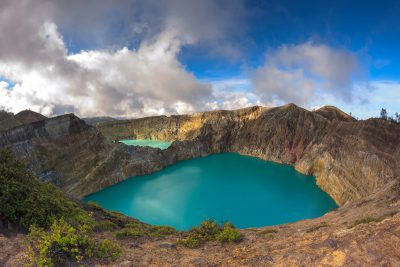 Claremont, Calif. (February 12, 2018)—The National Geographic Society has awarded Professor of Biology and Environmental Science Donald McFarlane and a team of researchers a grant to explore three acidic lakes in Indonesia. Using a small, remote-controlled, sonar-equipped boat, the scientists will map uncharted lake beds and measure the scalding, sulfuric waters on the summit of the Kelimutu volcano. The expedition, scheduled for January 2019, will help predict volcanic volatility.
Claremont, Calif. (February 12, 2018)—The National Geographic Society has awarded Professor of Biology and Environmental Science Donald McFarlane and a team of researchers a grant to explore three acidic lakes in Indonesia. Using a small, remote-controlled, sonar-equipped boat, the scientists will map uncharted lake beds and measure the scalding, sulfuric waters on the summit of the Kelimutu volcano. The expedition, scheduled for January 2019, will help predict volcanic volatility.
The specially equipped boat traverses the lake surface and allows the scientists to measure the depth of the lakes via sonar. The lakes are too heated for human navigation and are often referred to as the “tri-colored lakes” because they vary in hue, both from each other and over time. Once the team determines a lake’s depth, the scientists can calculate the volume of the water. They can then combine the lake’s volume and its surface area with the temperature of the water to figure out how much heat is stored in the lake. Since the lake loses heat from the surface, they can then estimate how fast the volcano is heating up the bottom of the lake.
“Those kinds of thermal calculations indicate volcanic activity,” said McFarlane, who teaches at the W.M. Keck Science Department, a joint program of Pitzer, Claremont McKenna and Scripps colleges. “Prior to eruptions, things warm up.”
This expedition builds on research McFarlane and this team of scientists conducted last year on a volcanic crater lake in Costa Rica. For that project, McFarlane’s colleague Guy van Rentergem, a chemical engineer, created an autonomous, aquatic drone rigged with sonar. To make sure the vessel could survive a boiling bath, he slathered epoxy all over an approximately 21-inch-long plastic bait boat and outfitted it with an above-water propeller.
Volcanologists can deploy this novel amphibious creation to safely and accurately measure the volume of active crater lakes. Since these eruption-prone lakes often spontaneously spew hot, corrosive water, scientists may be deterred from exploring them in a boat or on a raft. “You don’t want to get hit with a tsunami of hot acid,” McFarlane says.
 Professor of Biology and Environmental Science Donald McFarlane
Professor of Biology and Environmental Science Donald McFarlane
McFarlane and his co-researchers—Rentergem, Carleton University Professor Joyce Lundberg and volcanologist Carlos J. Ramírez—wrote about their Costa Rican findings in the article “An Autonomous Boat to Investigate Acidic Crater Lakes,” which appeared in the journal Eos. The Atlantic covered their discoveries, and Eos highlighted their work again in the article, “Thirteen Innovative Ways Humans Use Drones.”
Although the scientists will be able to build on lessons learned from their Poás volcano research project, they will face new challenges in Indonesia. The tri-colored lakes are remote and surrounded by cliffs—McFarlane estimates that it’s an approximately 400-foot drop down to the surface so launching their sonar boat will be tricky. McFarlane is a speleologist with decades of experience of rappelling into deep caves, but the cliffs surrounding the Indonesian lakes are “extremely soft and crumbly.”
McFarlane says the team is debating using a rope technique called a Tyrolean traverse, basically stretching a rope across the crater and mounting it with a pulley so a climber can descend, spider-like, to the lake’s surface. The problem? The team would need an awfully long rope and, if it works, “you’re landing in an acid bath at the bottom, which isn’t so great either,” said McFarlane.
Asked if they could use an aerial drone to deliver the aquatic drone, he said it might be possible to drop the boat in but not collect water samples.
“Plus we would miss out on the fun,” said McFarlane, who rappelled down to the crater lake in Costa Rica after a wave of battery-acid-like water disabled their drone boat.
So what’s the current working plan? “Think about it some more,” he said, summing up the first steps of any challenging scientific expedition.